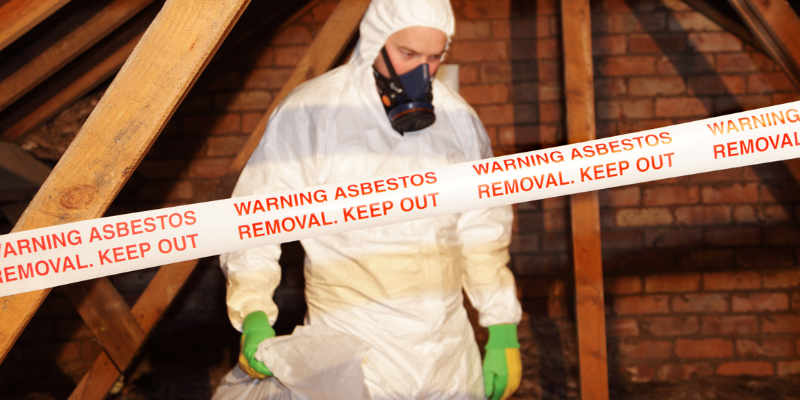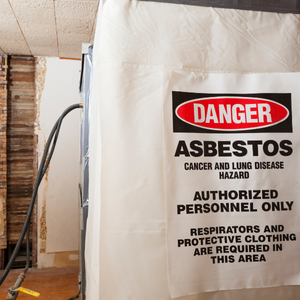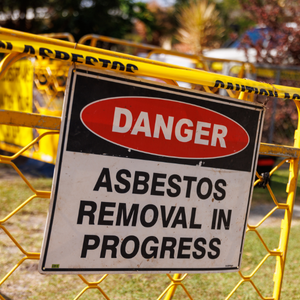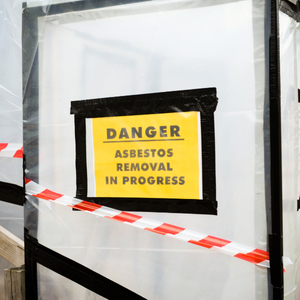
Asbestos removal isn’t something most Washington homeowners budget for until they have to. This is usually discovered when planning a renovation and needs to be tested first. It may also be that you already know it’s there and you’re finally ready to deal with it. Either way, you want to know what this is going to cost you — and Sell My House Fast For Cash can help you understand your options and connect with trusted professionals.
Washington homeowners typically spend between $1,200 and $3,300 for professional asbestos removal, though that range shifts quite a bit depending on your specific situation.
In this guide, we’ll walk you through what actually affects the price and what you can expect when you start getting quotes!
What Is Asbestos and Why Washington Homeowners Should Care
Asbestos is a mineral that construction crews loved for decades because it resisted fire and worked as great insulation. The problem showed up later when people started getting really sick from breathing in the microscopic fibers this stuff releases.
Those fibers cause lung cancer, mesothelioma, and asbestosis, but what makes it so dangerous is that you won’t feel sick for decades. By the time symptoms show up 20 or 30 years later, the damage is already done.
Asbestos that’s intact and undisturbed isn’t an immediate threat. However, once it starts deteriorating or gets disturbed during renovations, those fibers end up floating around in the air. Washington homes built before 1990 are likely to have asbestos somewhere inside.
Where Does Asbestos Hide in Washington Homes?

Popcorn ceilings are one of the biggest culprits, especially in homes from the 70s and 80s. Builders mixed asbestos right into that textured spray because it added fire resistance and helped with soundproofing.
Vinyl floor tiles are another common spot, along with the adhesive that holds them down.
Moreover, your pipes probably have old wrapping around them if your house is older, and that insulation often contains asbestos. The same goes for furnace insulation and the tape on HVAC ducts.
Cement siding on homes built before 1980 almost always has asbestos mixed into the material. Attic insulation, particularly the kind that looks like small gray pebbles (vermiculite), frequently contains it, too.
You can’t identify asbestos just by looking at it, which is why cost of asbestos removal before you start tearing anything out.
How Asbestos Affects Your Home’s Resale Value in Washington
Asbestos disclosure can knock 10% to 30% off your home’s value, depending on how buyers react and how much contamination exists. A $400,000 home might only fetch $280,000 to $360,000 with disclosed asbestos that needs removal.
Buyers freak out way more about visible asbestos in living spaces like popcorn ceilings and floor tiles than hidden pipe insulation in the basement they’ll never see.
Traditional buyers with conventional mortgages get spooked easily, and their lenders sometimes require removal before approving the loan. FHA and VA loans are particularly picky about asbestos because of strict property condition requirements.
Cash buyers and investors don’t have these lending restrictions. They’re usually more willing to work with you on as-is sales without demanding removal first.
Cost Breakdown by Room and Location in Your Home
Different areas of your home come with totally different price tags. Some of them might surprise you. Here’s what removal actually costs, depending on where the asbestos is hiding.
Roof and Shingles
Roof removal is the most expensive spot at $50 to $120 per square foot. Working at height is dangerous and containment gets really complicated up there. Contractors need serious safety gear, too, hence the price.
Plus, once the asbestos roofing comes off, you need a whole new roof installed, which tacks on another $6,000 to $13,000 to your total bill. It’s a lot, but you can’t exactly leave your house without a roof.
Siding
Asbestos-cement siding runs $3 to $15 per square foot to remove. A typical 1,500-square-foot home ends up costing between $10,500 and $22,500 for complete siding removal and disposal.
Many Washington homes built before 1980 have this type of siding because it was basically the standard back then.
Flooring and Tiles
Vinyl tiles and sheet flooring removal costs $5 to $15 per square foot. Your 200-square-foot kitchen project lands somewhere between $1,000 and $3,000, and that’s before you buy and install new flooring.
The adhesive under those old tiles usually contains asbestos, too. That is why contractors remove both the tiles and whatever’s sticking them down.
Walls and Popcorn Ceilings
Wall removal costs $8 to $13.50 per square foot when asbestos is lurking in the drywall or joint compound. Popcorn ceilings cost $9 to $20 per square foot to scrape off safely.
A lot of homeowners decide to just seal and cover their popcorn ceilings instead of removing them because that price can balloon for a whole house.
Attic Insulation
Attic removal varies a lot from $11 to $25 per square foot, depending on how much insulation you’ve got up there and whether contractors can move around easily or have to crawl through tight spaces.
After they haul out the old insulation, you’ll spend another $1,700 to $2,100 putting in new stuff so your attic actually keeps your house comfortable again.
Basement
Basement work costs $5 to $20 per square foot. Finished basements with drywall and ceiling tiles run about 25% more than unfinished ones. This is because contractors have to tear out all that finished material before they even get to the asbestos.
Open basements with exposed pipes and ceilings are way simpler to work in, which keeps costs on the lower end.
Pipes and HVAC Ducts
Pipe insulation removal costs $5 to $15 per square foot or $2 to $5 per linear foot if it’s just wrapping around the pipes. HVAC ducts are trickier and more expensive at $35 to $55 per square foot because contractors are working in tight, awkward spaces.
Sometimes, it actually makes more financial sense to replace your whole HVAC system for $5,000 to $12,500 instead of trying to remediate decades-old ductwork.
Asbestos Testing Costs in Washington
Testing runs between $250 and $850 in Washington and you need to do this before anyone starts tearing anything out. Most homeowners pay around $400 for standard testing of three to five samples taken from different areas of their home.
Simple material sampling, where they just take a chunk of suspected material, costs less than full air quality testing throughout your entire house.
Always hire an independent testing company before you even talk to removal contractors. This keeps things honest because testing companies that also do removal have a financial incentive to find asbestos everywhere. If the test confirms the presence of asbestos and you’d rather not deal with removal costs, you can sell your home for cash in Sumner or nearby cities and move on without the extra expense.
Independent testers just tell you what’s actually there, which will give you detailed information when you start collecting quotes. Results usually come back within one to three business days.
Yeah, testing feels like an extra expense when you’re already stressed about costs, but it can save you thousands if those materials you’re worried about turn out to be asbestos-free.
Your Asbestos Treatment Options: Removal vs. Encapsulation
You don’t always have to rip everything out, which is great news for your budget. There are cases where sealing the asbestos in place works just as well and costs way less.
Complete Removal: When and Why
Removal means contractors will tear out all the asbestos-containing materials and haul them away for proper disposal. You need this option when the materials are already damaged, crumbling, or falling apart because they’re actively releasing fibers into your air.
If you’re planning a kitchen remodel or knocking down walls, you’ll need removal since construction work disturbs the asbestos. Meanwhile, if you’re selling your home in the near future, buyers will usually feel more comfortable with a complete removal rather than just sealing it up.
This approach starts at $5 per square foot for interior work and gets rid of the problem for good.
Encapsulation: A Cost-Effective Alternative
Encapsulation costs $2 to $6 per square foot, which is roughly half what you’d pay for removal. Contractors spray or paint special sealants over the asbestos that lock those fibers in place so they can’t go airborne. This works really well for asbestos that’s in good shape and won’t be disturbed by renovations or daily wear and tear.
If you’re planning to stay in your home long-term and the material is stable, encapsulation could save you several thousand dollars while still keeping your family completely safe from exposure.
Additional Costs to Budget For
Removal costs don’t tell the whole story, and you’ll be kicking yourself if you don’t plan for these extra expenses that always seem to pop up.
Disposal Fees and Permits
Washington treats asbestos like the hazardous waste it is, which means strict rules about where it goes and how it gets there. Disposal fees run $10 to $50 per cubic yard, depending on your county.
Permits cost another $50 to $100. Most contractors bundle these fees into their overall quote, but you absolutely need to confirm that before you sign anything.
Don’t even think about tossing asbestos in your regular trash because Washington will slam you with fines that can hit $10,000 per day for improper disposal. That’s not a typo.
Replacement Materials and Repairs

Removal leaves your home with holes, gaps, and missing materials that need fixing. Ripped-out drywall needs replacing at about $3 per square foot. Meanwhile, new roofing after asbestos shingle removal costs $6,000 to $13,000.
Floor replacement depends totally on what you choose, but you’re paying for materials and installation either way. HVAC duct replacement runs around $3,500.
You need to budget separately for these repairs so you’re not caught off guard when contractors give you the full project total and it’s way higher than the removal estimate you were expecting.
Washington State Asbestos Regulations You Need to Know
Washington, just like other states, has strict asbestos laws, and honestly, that’s a good thing for your safety. You need to know what’s required before you start any project, so you don’t end up with fines on top of removal costs. If handling all that feels overwhelming, you can sell your home for cash in South Hill or nearby cities and let the buyer take care of the regulations and repairs.
Legal Requirements for Homeowners
The Department of Labor & Industries requires certified professionals for pretty much all asbestos work in Washington. Homeowners can legally remove asbestos from their own primary residence, but they still have to follow proper disposal rules, even if they do it themselves.
Before any major demolition or renovation, Washington law requires asbestos surveys for properties built before 2004. This applies to both homes and commercial buildings.
Regional rules change depending on where you live in the state. You need to check with your local air quality agency for the specific requirements in your county before you start anything.
Code Violations and Compliance Issues
Damaged asbestos that’s actively releasing fibers into your home can trigger code violations from your local building department. Improper removal or disposal creates violations that come with really hefty fines you don’t want to deal with.
Every business doing asbestos abatement has to maintain written hazardous materials policies and run regular OSHA-compliant employee training.
When you’re hiring contractors, you should verify that they actually follow these required practices. This is so you don’t end up liable for their mistakes.
Should You Remove Asbestos Yourself?
DIY asbestos removal is technically legal for single-family homeowners in Washington, but legal doesn’t mean it’s wise.
Professional crews show up with negative air pressure containment systems, HEPA-filtered vacuums that actually trap asbestos fibers, proper respirators rated for this work, and decontamination chambers.
That dust mask from your hardware store won’t do anything against microscopic asbestos fibers floating in the air.
Professionals knock out the job in days instead of the weeks it would take you fumbling through it. They guarantee complete removal and give you documentation proving proper disposal, which becomes really important paperwork when you eventually sell your home.
Still determined to go the DIY route? Contact your local clean air agency first to get their specific requirements in writing.
You’ll also need specialized equipment that costs a fortune to buy or rent, proper PPE that actually protects you, and disposal arrangements at approved facilities. Honestly, some OSHA training wouldn’t hurt either.
Most homeowners realize pretty quickly that hiring pros just makes way more sense.
How to Find and Hire Qualified Asbestos Contractors in Washington
Finding the right contractor takes a bit of legwork, but Washington’s strict regulations actually work in your favor here because they weed out the fake contractors.
Required Certifications and Licenses
You can start with the Labor and Industries website, where you can look up licensed asbestos removal companies in Washington. Certification isn’t negotiable. It’s your bare minimum requirement.
Don’t waste your time talking to uncertified contractors, no matter how good their price sounds. Request proof of asbestos liability insurance, too, because this will protect you if something goes sideways during the project.
Legitimate contractors have this documentation ready to show you without hesitation.
Getting Multiple Quotes
Get at least three written estimates so you can compare what different contractors are offering. Prices shouldn’t swing more than 20% between quotes for the same job.
When estimates are wildly different, it usually means someone doesn’t actually understand the scope of your project or what it involves. Super low bids might seem tempting, but they often lead to contractors cheaping out on safety or hitting you with surprise “additional costs” halfway through the job.
Compare what each contractor includes in their quote because disposal fees, permits and final air testing should all be covered in that number.
Important Questions to Ask
Ask how long they’ve been removing asbestos and whether they can provide references from similar projects. Find out exactly what containment methods they use and how they handle disposal afterward. Ask how they verify complete removal once the work is done.
Professional contractors actually welcome these tough questions instead of getting defensive or dodging them. Their answers will tell you a lot about whether they know what they’re doing and take the work seriously.
What Happens During Professional Asbestos Removal
Knowing what to expect helps you prepare your home and your family for the disruption that’s about to happen, because this isn’t a quick in-and-out job.
Preparation and Containment
Professionals seal off the entire work area with thick plastic sheeting and heavy-duty duct tape. They set up equipment to create negative air pressure inside the sealed zone so asbestos fibers physically can’t escape into the rest of your home.
You’ll need to clear out of the area during the work. Meanwhile, for major projects, you might need to leave your entire house for several days. Contractors will shut down your HVAC system and seal all the air ducts to prevent contamination from spreading through your ventilation.
The Removal Process
Workers suit up in full protective gear, including respirators and disposable coveralls that they’ll throw away after the job. They keep all the materials wet during removal because water weighs down the fibers and stops them from becoming airborne.
Everything they remove gets sealed into specially labeled containers that meet EPA requirements for hazardous waste transportation. The actual removal work typically takes two to five days for most residential projects, though bigger jobs with extensive contamination might stretch into a couple of weeks.
Cleanup and Final Inspection
After removal comes really thorough cleaning with HEPA vacuums and wet wiping of every single surface in the work area. They run air quality tests to verify the space is actually safe before they pull down the containment barriers.
You’ll get documentation showing proper disposal and clean air test results that prove the job was done right. Keep these records in a safe place because future buyers will want to see proof of professional remediation when you sell.
Can Cash Buyers Handle Asbestos and Code Violations?

Cash buyers are actually pretty chill about asbestos, which is a refreshing change from traditional buyers who freak out the second they hear the word. These buyers purchase homes as-is all the time, including properties with asbestos lurking in the ceiling, walls, or wherever else it decides to hide.
You tell them about the asbestos, they factor the remediation costs into their offer, and that’s it. Done deal.
They work with asbestos professionals regularly and know exactly what removal actually costs instead of imagining worst-case scenarios that inflate the numbers in their heads. Some cash buyers even specialize in buying homes with environmental issues like asbestos because they understand the process and aren’t scared off by it.
Frequently Asked Questions
Does homeowners’ insurance cover asbestos removal in Washington?
Homeowners insurance typically doesn’t cover asbestos removal unless it’s directly related to a covered loss like a fire or storm damage. Some policies might include remediation coverage up to a certain dollar limit, maybe $10,000, but only when it’s connected to an insured event.
Regular asbestos removal for renovations or safety reasons comes out of your own pocket. Check your specific policy documents to see what’s actually covered, but don’t count on insurance to pay for this.
How long does asbestos removal take?
Most residential asbestos removal projects take two to five days from start to finish. Small jobs like removing tiles from one room might only take a day or two. Larger projects with multiple contaminated areas or whole-home remediation can stretch into a couple of weeks.
The timeline will depend on how much asbestos needs removal, where it’s located, and how complicated the containment setup needs to be.
Can I stay in my house during asbestos removal?
You’ll need to stay out of the work area during removal, and for major projects, you should probably leave your entire house. Contractors seal off contaminated zones to prevent fiber spread, but it’s safer for you and your family to stay elsewhere while the work happens.
Small, contained projects might let you stay in other parts of your house, but you should still ask your contractor what they recommend for your specific situation.
Is encapsulation as safe as complete removal?
Encapsulation is completely safe when done properly on asbestos that’s in good condition. The sealants will lock fibers in place so they can’t become airborne and cause health problems. It works great for stable materials that won’t be disturbed.
Complete removal is better when materials are damaged, you’re planning renovations, or you want the asbestos permanently gone. Both options protect your health when done by certified professionals.
What happens if I don’t remove asbestos from my home?
Asbestos that’s intact and undisturbed doesn’t pose an immediate health risk, so you’re not required to remove it just because it exists. The danger comes when materials deteriorate, get damaged, or are disturbed during renovations.
If you leave it alone and it stays in good condition, you can live with it safely. But you’ll need to disclose it when you sell and buyers might demand removal or a price reduction.
How do I know if my home has asbestos?
You can’t tell just by looking at materials. Homes built before 1990 in Washington are likely to have asbestos somewhere, especially in popcorn ceilings, vinyl tiles, pipe insulation, and cement siding. The only way to know for sure is professional testing, where certified inspectors take samples and send them to a lab.
Testing costs $250 to $850 and gives you definitive answers before you start any renovation work.
What’s the difference between friable and non-friable asbestos?
Friable asbestos can be crumbled or crushed by hand pressure, which makes it way more dangerous because fibers are released into the air easily. Things like loose insulation, damaged ceiling texture, and deteriorating pipe wrapping are friable.
Non-friable asbestos is bound tightly in materials like vinyl tiles, cement siding, and roofing shingles that won’t release fibers unless you break, sand, or cut them. Friable asbestos costs more to remove because it requires extra safety precautions.
Do I need a permit to remove asbestos in Washington?
Yes, you need permits for asbestos removal in Washington and your contractor should handle getting them. Permit costs run $50 to $100 depending on your county.
Even if you’re doing DIY removal as a homeowner, you still need to notify your local air quality agency and follow their disposal requirements.
Skipping permits can result in fines and legal problems, especially if your neighbors report the work or if issues come up when you try to sell later.
Key Takeaways: Cost of Asbestos Removal in Washington
Asbestos removal in Washington costs $1,200 to $3,300 for most projects, but exterior work and whole-home remediation can easily hit $15,000 or more. Interior removal runs $5 to $20 per square foot, while exterior projects jump to $50 to $150 per square foot.
If asbestos removal costs feel overwhelming or you just don’t want to deal with the hassle, Sell My House Fast For Cash offers a simple alternative. We buy houses as-is with asbestos issues, no remediation required, no lengthy negotiations. Contact us today at (866) 824-3222 for a no-obligation cash offer and skip the stress of asbestos removal entirely!
Helpful Washington Blog Articles
- Refinance A House After Divorce in Washington
- Condemned House Requirements in Washington
- How to Avoid Closing Costs in Washington
- How to Sell a Condemned House in Washington
- Can the Seller Back Out of a Contract?
- Selling a House with Termite Damage in Washington
- Cost of Asbestos Removal in Washington
- Sell a House with a Code Violation in Washington
- Understanding FSBO Costs in Washington
- Who Pays the HOA Fees at Closing in Washington?
- How to Sell a Hoarder House in Washington
- How Long After an Appraisal Can You Close in Washington?

